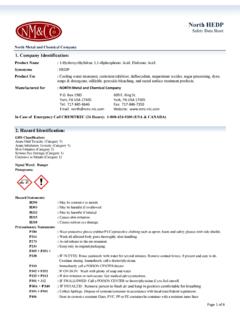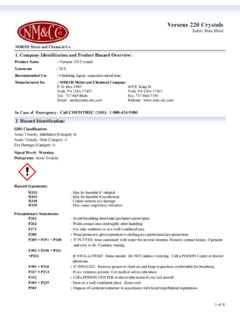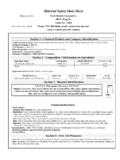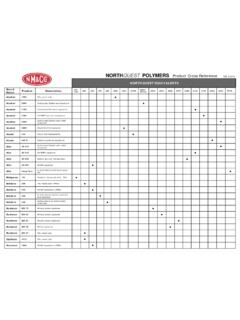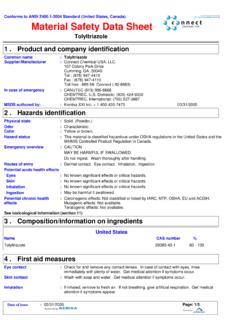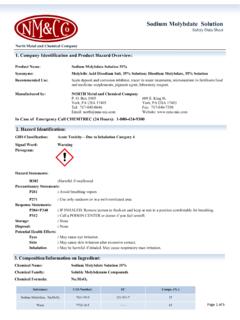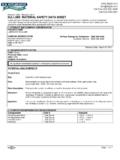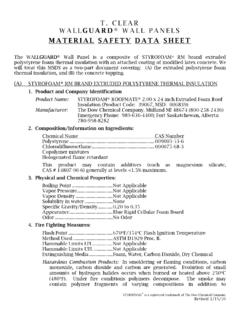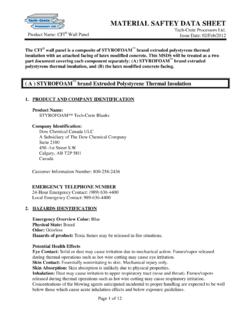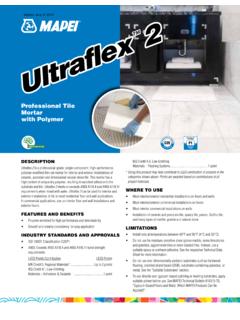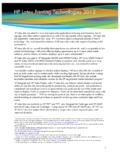Transcription of Safety Data Sheet - nmc-nic.com
1 Material Safety data Sheet Distributed by: North Metal & Chemical Co. 609 E. King St. , PO Box 1904, York PA 17403. Phone: (717) 845-8646; email: NORTHQUEST 3100. Date of Preparation: 7/6/2007 Date / review: 01/28/10 Page 1/5. Section 1 - Chemical Product and Company Identification Chemical name: Ter-polymer of acrylic acid/AMPS. Chemical Family: NA. Formula: NA. Producer/importer identification: Designation: Aquaquest Water Treatment Chemicals Point of business or residence: GIDC Industrial Estate, PANOLI, Gujarat, INDIA. Telephone: +91 79 25465851 Fax: +91 79 25341200.
2 Section 2 - Composition / Information on Ingredients Ter Polymer of Acrylic acid/AMPS 40623-75-4 Proprietary composition Section 3 - Substance or preparation hazard indications Appearance Clear colorless/pale yellow liquid Eyes May cause significant irritation to the eyes Skin May cause significant irritation to the skin Ingetstion No more than slightly toxic if swallowed. Significant adverse health effects are not expected to develop if only small amounts (less than a mouthful) are swallowed Inhalation Moderately irritating if inhaled Signs and Symptoms of Eyes: Redness and possible itching Overexposure Skin: Redness and/or itching of the skin Ingestion: Possible nausea and/or vomiting Inhalation: Possible coughing, nasal congestion, burning, tyghtness of chest and/or shortness of breath Acute Toxicity: No test data is available for acute dermal toxicity.
3 No test data is available for acute oral toxicity. No test data is available for acute inhalation toxicity. Carcinogenicity No data available Mutagenicity No data available Section 4 - First aid instructions Eyes: Flush with running water for at least fifteen minutes. Get medical aid. Skin: Flush with running water for 15 minutes minimum. If irritation persists, get medical aid. Ingestion: If the product is swallowed, CALL PHYSICIAN OR POISON. CONTROL CENTRE FOR MOST CURRENT INFORMATION, Get immediate medical aid. Inhalation: Remove from further exposure. Keep warm and at rest.
4 If cough or other symptoms develop, seek medical attention immediately. Section 5 - Instructions for a case of fire occurence Page 2/5. Flash Point (C): Above 100 C. Flammable Limits: Not applicable Autoignition Temp. Not applicable Flammable class: Not applicable Flame Propagation or Burning Not available rate of Solids: General Hazard: Evacuate personnel downwind in order to avoid inhalation of irritating and/or harmful fumes and smoke. Extinguishing Media: Water spray. Chemical-type foam. Appropriate for the surrounding area. Hazardous Combustion Carbon monoxide, carbon dioxide products: Fire fighting procedures: This product is a nonflammable substance.
5 However, hazardous decomposition and combustion products may be formed in fire situation. Cool exposed containers with water spray to prevent overheating. Fire fighting equipment: Respiratory and eye protection are required for fire fighting personnel. Full protective equipment (bunker gear) and self contained breathing apparatus (SCBA) should be used for all indoor fires and any significant outdoor fires. Evauate area and fight fire from safe distance or a protected location. Move fire-exposed containers if it can be done without risk to firefighters. If possible, firefighters should control run-off water to prevent environmental contamination.
6 Sensitive to static discharge: Not sensitive Sensitivity to Mechanical Not sensitive Impact: Section 6 - Measures in case of accidental escape Small Spill: Incidental releases should be cleaned-up promptly by personnel wearing goggles, rubber gloves and appropriate body protection. Large Spill: In the event of non-incidental release, minimum personal protective equipment should be Level C: triple-gloves (rubber gloves and nitrile gloves, over latex gloves), chemically resistant suit and boots, hard-hat, and Air-Purifying Respirator with a high efficiency particulate filter.
7 Level B, which includes a self-contained breathing apparatus, must be worn in situations where water-contaminated product is generating fumigant gas, and oxygen levels are below or are unknown. Sweep up or vacuum spilled material carefully. Rinse the contaminated area with soapy water only after removing as much material as possible. Decontaminate the area thoroughly. Place all spill residues in an appropriate, labeled container and seal immediately. Dispose of in accordance with Federal, State, local hazardous waste disposal regulations. Environmental Precautions Water spill: Use appropriate containment to avoid runoff or release to sewer or waterways.
8 Land spill: Use appropriate containment to avoid run off or release to ground. General Procedures: remove containers of strong Acid and alkali from the release area. Release notes: If spill could potentially enter any waterway, including intermittent dry creeks, contact the local authorities. Page 3/5. Section 7 - Instructions for handling and storage Handling: Use appropriate personal protective equipment as specified in Section 8. Handle in a well-ventilated area. Handle and use in a manner consistent with good industrial/manufacturing techniques and practices.
9 Storage: Recommended storage temperature is below 35 C (95 F). Section 8 - Exposition control and personal protection Engineering Controls Use appropriate engineering controls to minimize exposure to vapors generated via routine use. Personal Protective Equipment Eyes and Face: Wear Safety glasses with side shields or gaggles when handling this material. Skin: To prevent any contact, wear impervious protective clothing such as rubber gloves, apron, boots or whole bodysuit, as appropriate Respiratory: Avoid breathing vapor or mist. Use approved respiratory protection equipment when airborne exposure is excessive.
10 Work Hygienic Practices Facilities storing or using this material should be equipped with eyewash facility and a Safety shower. Comments It contains no known hazardous ingredients. No specific occupational exposure limit has been established. Section 9 - Physical and chemical characteristics Physical State Liquid Odour Characteristic Appearance Viscous liquid Color Colorless pH Boiling Point >100 C. Vapour Pressure Practically 0. Freezing Point < -5 C. Melting Point NA. Solubility in water Soluble Evaporation Rate Not applicable Density Molecular Formula NA. Molecular Weight NA.

